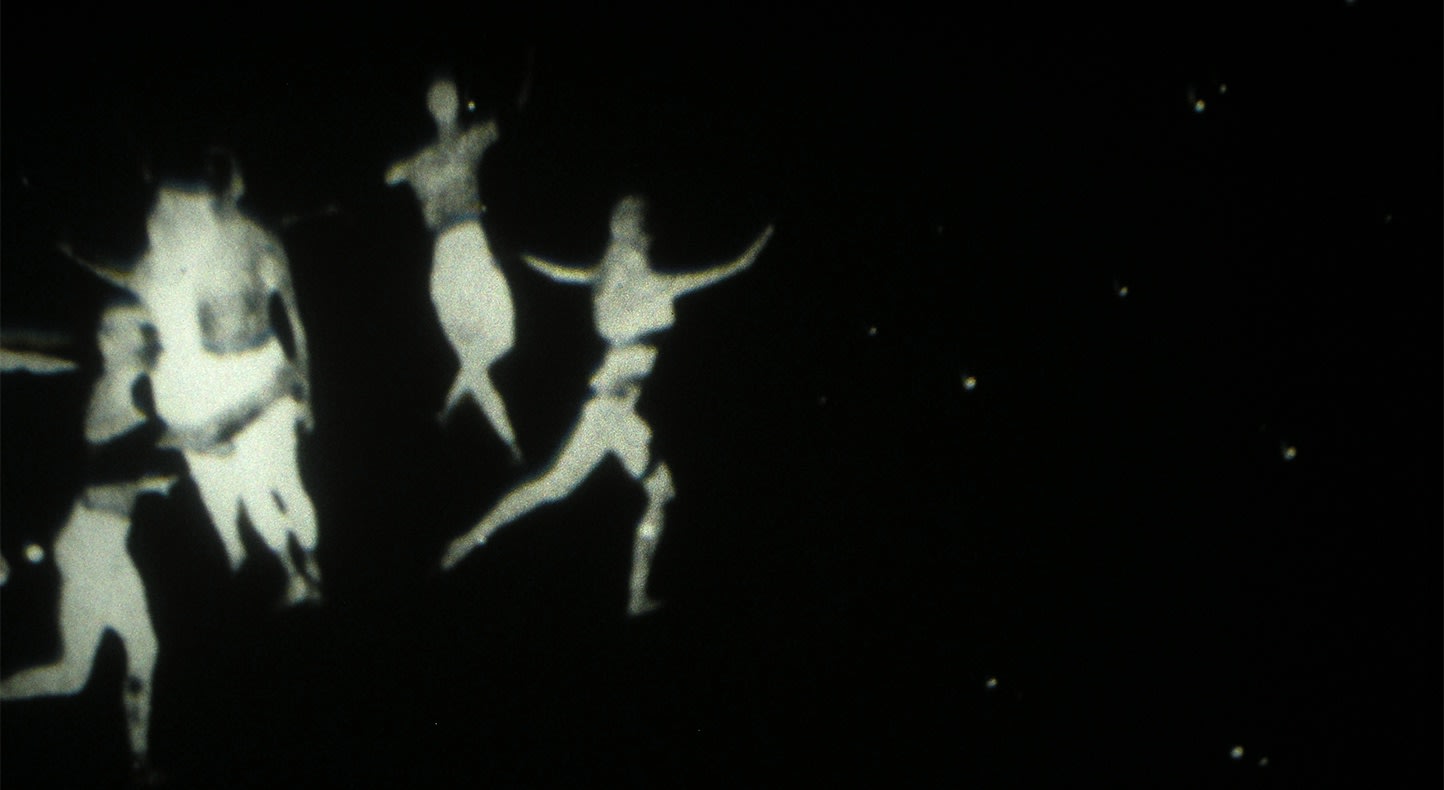in flux: artists’ film screenings: Maya Deren | Meredith Monk | Marikki Hakola
For centuries, artists have explored the limits and possibilities of representing the human body, in motion and in space. In dance and performance, this body – breathing, tangible, moving in real space and time – becomes an artistic material through which meaning and emotion are communicated. The artwork’s relation to reality is strange and unsettled: personal, visceral, and yet also arranged and choreographed, replete with metaphor.
The three works in this two-week long screening programme each provide a powerful depiction of this ambiguous state. These are not ‘live’ art performances, but rather works of moving image that utilise the technologies of film and video to both record the body in motion, and to create a new artistic time and space in which the performers exist. In each work, a very different world of sight and sound is created according to the unique creative vision of each artist, each employing different moving image manipulations and technologies as they evolve over time, from black-and-white negative film to electronic brushwork. At the centre of each world, however, remains the body in choreographed motion – whether a celestial ballet, a multi-disciplinary performance or a techno dance video – projected onto the same blank white wall, in an entrancing exploration of sexuality, identity, the body’s expressive power, and technologies of moving image.
Maya Deren’sThe Very Eye of Night (1958) is the sixth and final film completed by the legendary avant-garde filmmaker, who is celebrated for her pioneering role in the development of film-dance or “choreocinema”. Deren carefully theorised her own unique approach to film-making, describing it as metaphysical, poetic, experimental and choreographic. Thus her works seek to communicate significant meaning and ideas through highly stylised and ritualised movement, while attending closely to the medium of film through which they are created.
In The Very Eye of Night ballet dancers, individually named after figures from Greek mythology, shown in ghostly photographic negative, move against a starfield background. They are accompanied by an original score conceived by Teijo Ito. Deren collaborated with the celebrated choreographer of modern ballet, Antony Tudor, and nine students from the Metropolitan Opera Ballet school, to choreograph the dancers’ movement. However, it is through Deren’s filmic manipulations that the dancers are freed from physical boundaries of gravity and reality, and the work enters a realm of metaphysical meaning. In Deren’s words: ‘The blackness of night erases all horizons and, released from the levelling pressure of this plane, the movements both of the dancers and of the camera become as four-dimensional and directional as those of birds in air or fish in water.’ (“Statement of Purpose for The Very Eye of Night” (1959) in Essential Deren, Collected Writings on Film by Maya Deren, ed. Bruce R. McPherson (2005)).
Meredith Monk and Robert Withers’ 1977 filmed reconstruction of Monk’s 1966 performance 16 Millimeter Earrings takes the viewer to the heart of her poetic, hallucinatory world of layered music, image, movement and film. Monk is celebrated for her visionary approach to performance, weaving together vocal and musical innovations with movement, image, object, light and sound in order to discover new modes of perception. She has described her multi-disciplinary practice as ‘work[ing] in between the cracks, where the voice starts dancing, where the body starts singing, where theater becomes cinema’.
Monk originally presented 16 Millimeter Earrings live on the 5th and 6th of December 1966 at the Judson Memorial Church, which was a nexus for artists working across fields to experiment with the boundaries of dance, music, poetry, theatre and visual art. 16 Millimeter Earrings explored the artistic, expressive potential of different kinds of manipulated matter from the artist’s own life, from Monk’s choreographed body and recorded voice (whether reading Wilhelm Reich’s 1940 ‘The Function of the Orgasm’ or performing traditional English folk song ‘Greensleeves’ or her own music) to physical objects and film projected on various surfaces. While Withers’ filmic interpretation rearranges Monk’s soundtrack thus creating a different juxtaposition of sound and image from the original, it captures the essence of this pivotal work – a prototype for interdisciplinary and performance art.
Original performance credits for 16 Millimeter Earrings (1966):
Conception, music, objects, costumes, films: Meredith Monk
Camera: Kenneth Van Sickle
Performer: Meredith Monk
Finnish artist Marikki Hakola has been working with performance as well as video and new media technologies since 1982, creating a diverse range of Internet projects, interactive installations, multimedia performances, and dance and music films that place Hakola at the forefront of media art research and practice within Europe. Hakola’s TransVersum (1993) is an ambitious exploration of the possibilities of electronic moving image, not just as a technological medium but as a powerful means of expressing the condition of human existence in a post-industrial Zeitgeist.
TransVersum takes the form of an expanded dance video, directed by Hakola and constructed around a choreographed stage dance by Ismo-Pekka Heikinheimo, ‘Come Quickly for I’m Seeing Stars’. Using an electronic brush, Hakola transforms the projected image as well as the environment it represents. The dancers seek to express their personal and sexual identities through their bodies, moving through an artificial space that seems both to liberate and entrap them.
Credits for TransVersum:
Script, Direction, Visual Design & Editing: Marikki Hakola
Choreography: Ismo-Pekka Heikinheimo
Dancers: Mikael Aaltonen, Pia Karaspuro, Michelle Levi, Maria Littow, Urmas Poolamets
Sound and Music: Marko Kataja, Epa Tamminen, Drostan Madden, Gustav Alenius
Camera: Raimo Uunila, Veli Granö
Lights: Kimmo Karjunen, Epa Tamminen
Stage Set Design: Marja Valtonen
Costumes: Jaakko Selin
Animation, Graphics: Milla Moilanen
Producer: Marikki Hakola
Production: Kaligari 1993
Digital Re-Mastering: Kroma Productions Ltd. 2016
Please note special extended gallery hours, open for in flux from Tuesday to Saturday, 11am - 6pm.




